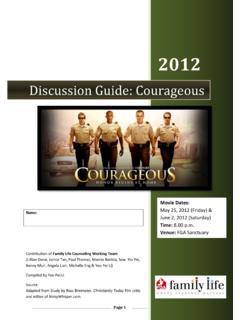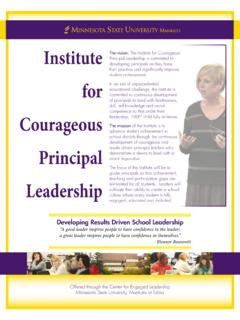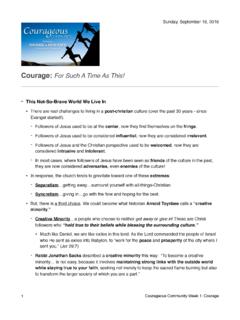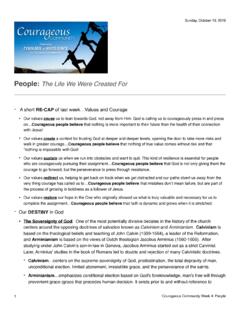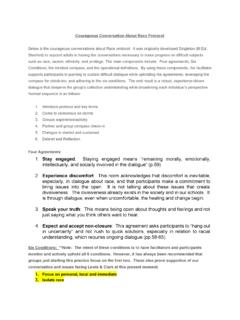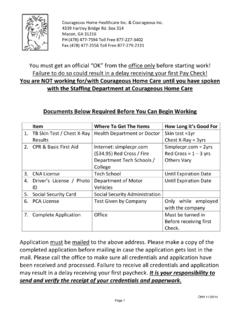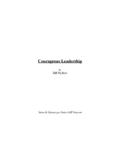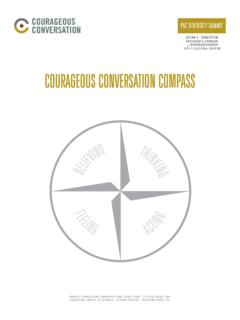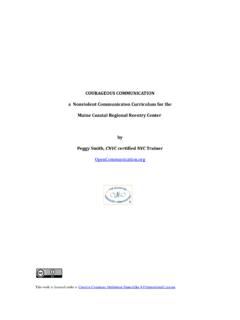Transcription of Courageous Plan Design - Sapers & Wallack
1 Courageous plan Design Readying Employees for Retirement Through Bold LeadershipCourageous plan Design : Readying Employees for Retirement Through Bold Leadership 2 Begin SavingSteps To Not SaveEnrollReview Investments OptionsChoose Salary Deferral RateSelect Allocation MixAnnually Increase Save or Save IntroductionEnormous resources are going toward encouraging employees to participate in their employer s 401(k) plan . After all, if the benefits are made clear and it s easy to enroll, who wouldn t take full advantage? Yet three decades after the 401(k) s debut, employees still contribute too little to their plan or not at all, leaving them ill-prepared for retirement. Why?The problem isn t education, access or, as some claim, a broken system. It s, in a word, inertia. Employees struggle to act in their own best interests even when they know it could improve their financial future. That s why employers need to ensure that it takes less effort to succeed at saving for retirement than to fail.
2 The way to do that is with Courageous plan traditional 401(k) plan Design , employees must take several steps to begin saving: enroll, review investment options, choose a salary deferral rate, select an allocation mix and more. To not save, all they have to do is, well, nothing. It s obvious which is easier. Courageous plan Design flips the paradigm, shifting the initial decision-making responsibilities back to employers that recognize their central role in workers retirement on inertia s doggedness, Courageous plan Design embraces automatic features that force employees to take action to opt out of a 401(k) instead of in. Aggressive automatic deferral rates and automatic contribution rate escalation (auto escalation) replace standard plan recommendations, and participation longevity is encouraged through generous matches and the opportunity to diversify tax strategies. These and other forward-thinking plan elements, including stringent savings leak prevention and simplified investing options, can position employees for long-term financial stability and provide companies an even greater opportunity to 401(k) plan Design Automatic enrollment of new and existing employees with a 6 percent or higher default contribution rateAutomatic 2 percent escalation of the default contribution rate each year, with no capAn approved qualified default investment alternativeA generous and creative matching programA Roth 401(k) optionNo plan loan or hardship withdrawal optionsLimited investment optionsExclude company stockCourageous plan Design .
3 Readying Employees for Retirement Through Bold Leadership 3 Helping Employees Help ThemselvesOnly 13 percent of workers are very confident they ll have enough money to live comfortably in retirement, according to the Employee Benefit Research Institute s (EBRI) 2013 retirement confidence The fact that the same survey reveals only 2 percent of workers identify saving or planning for retirement as the most pressing financial issue facing most Americans today isn t just saying something; it s screaming it: Employers need to have the courage to step back into the retirement readiness the 1980s, our nation began moving away from pension strategies controlled by employers to 401(k) plans that place savings decisions squarely on employees shoulders. During that transition, an unanticipated problem emerged. Despite nearly $1 billion spent each year on investment education and support, plan participants often make poor and uninformed decisions.
4 The most problematic? The decision to do little or Behavioral finance, which examines investment decisions through the lens of psychology, points to reasons such as loss aversion, procrastination and a lack of investor discipline. Workers cite financial concerns more immediate than retirement, with EBRI s study finding that cost of living and day-to-day expenses top the list of reasons they don t contribute or contribute too little to their employer s In addition, 55 percent of those workers say they struggle with debt. Regardless of the rationale, relegating retirement savings to the back burner shouldn t be an easy option. A Courageous plan Design that hinges on automatic features, including automatic enrollment and automatic escalation of deferral rates, ensures it isn show that the contribution rate is the most significant factor in the size of an employee s final account balance, even more than investment selection or asset By automatically enrolling employees at a significant deferral rate (with the ability to opt out or change set contribution amounts, which many employees lack the momentum to do) automatic features are driving higher participation and deferral rates, according to RetirementConfidenceat a GlanceNot at All ConfidentSomewhat ConfidentVery ConfidentNot too Confident13%28%38%21%Source: The 2013 Retirement Confidence Survey: Perceived Savings Needs Outpace Reality for Many.
5 Employee Benefit Research Institute Issue Brief, No. 384. March show that the contribution rate is the most significant factor in the size of an employee s final account balance, even more than investment selection or asset plan Design : Readying Employees for Retirement Through Bold Leadership 4 The Proven Power of Automatic FeaturesDespite the success that early adopters have found with automatic features, some employers are uncomfortable with the notion that this progressive plan Design means being paternalistic. They question if it s their role to coerce employees to act in a certain way. The reality is that no matter how a plan is designed, employees are being steered in some direction. Automation steers them onto a path of saving for their retirement while still giving them the freedom to make their own choices should they decide a different option is best. Avoiding automation, in effect, simply defaults employees to a savings rate of 0 percent, sending a message that their ability to comfortably retire on time is of little concern to their EnrollmentAutomatic enrollment empowers employers to act in their employees best interests by setting them up to build retirement savings with pretax employee contributions.
6 The Pension Protection Act of 2006 (PPA) threw open the door to automatic enrollment, permitting an employer to automatically deduct deferrals from an employee s wages unless the employee actively elects to cease contributions or contribute a different amount. While auto enrollment was possible prior to PPA, employers were tremendously reluctant to use it until the act addressed liability concerns pertaining to deducting contributions without prior approval and making investment choices without participant 2011, 56 percent of plan sponsors automatically enrolled employees, compared to 14 percent in 2003, according to an article by Shlomo Benartzi and Richard Opt-out rates averaged only 10 percent. Extensive research shows that there s little question this feature boosts enrollment, with one study showing that 70 percent of companies find it Extremely/Very successful in offering participants better investment performance than they would achieve on their This finding is supported by the fact that employers that added automatic enrollment increased their participation rates from 69 percent to 81 percent an increase of 12 percentage Despite its positive influence on plan participation, automatic enrollment by itself doesn t constitute Courageous plan Design .
7 Recently, the feature faced a sharp backlash as research began to show that it can actually result in less savings for an employee. For example, a recent study found that participants who were automatically enrolled into a 401(k) contributed, on average, 1 percent less than participants who actively Over time, that seemingly small number can make a large difference in retirement savings feature, however, isn t the culprit; the automatic deferral rate an employer chooses to set is the real issue. Once the rate is set, the same inertia that keeps employees from enrolling on their own keeps them from raising it, which they should over time. About three-quarters of plans that use automatic enrollment set employees initial saving rate at just 3 percent of The idea of 3 percent which won t generate sufficient retirement savings for most employees is based on the starting point set out in PPA as well as on the concern that employees will scoff at anything higher and actually opt out of the reality is that no matter how a plan is designed, employees are being steered in some direction.
8 Automation steers them onto a path of saving for their enrollment by itself doesn t constitute Courageous plan Design . Courageous plan Design : Readying Employees for Retirement Through Bold Leadership 5In reality, when employers use a 6 percent rate versus 3 percent, there s very little increase in the opt-out That s a critical point because placing the default saving rate at 6 percent significantly increases the chance for both low- and high-income workers to successfully achieve retirement adequacy, according to an EBRI study that defines success as an 80 percent replacement income (See illustration below)But in Courageous plan Design , 6 percent is just the starting point. To continue to guide employees toward a sound retirement once they re in a 401(k) plan , the next essential step is implementing auto EscalationAuto escalation, annually increasing the automatic deferral rate, is arguably one of the most powerful tools employers have to bolster employee retirement readiness.
9 This plan Design feature, offered by 51 percent of employers,13 can help more employees reach the oft-recommended 10 percent deferral rate within a reasonable amount of time. Plans with automatic escalation report average deferral rates of 8 percent or higher compared to the average deferral rates of 4 percent or less for the majority of plans in Research is finding that, in general, employees aren t opting out of automatic escalation. One recent survey found that more than two-thirds of plans with automatic escalation have opt-out rates lower than 10 percent, and half have opt-out rates less than 5 The most common automatic escalation is 1 percent per year until the participant reaches a total of 10 percent, which is consistent with PPA requirements for safe harbor plans. A 2013 survey of 401(k) trends found that 97 percent of companies using auto escalation increase the default at this Courageous plan Design raises the bar to a 2 percent increase per year, thus reducing the time it takes for participants to reach higher contribution rates.
10 It is also recommended to not cap the increase at 10 percent, effectively allowing the participant contributions to increase until they reach their salary deferral limit (for 2014, the lesser of $17,500 or 100 percent of income, or $23,000 if age 50 or older).The impact of raising the default contribution rate from 3 percent to 6 percent on younger workers with 31 to 40 years of simulated 401(k) eligibilityLowestincomequartileHighestin comequartile25%IncreaseEmployees who achieve a financially successful retirement*Employees who achieve a financially successful retirement*18%IncreaseSource: Increasing Default Deferral Rates in Automatic Enrollment 401(k) Plans: The Impact on Retirement Savings Success in Plans with Automatic Escalation. Jack L. VanDerhei, Employee Benefit Research Institute, Notes, Vol. 33., No. 9. September escalation is arguably one of most powerful tools employers have to bolster employee retirement plan Design : Readying Employees for Retirement Through Bold Leadership 6It should be noted that employers that want their plan to qualify for the nondiscrimination testing safe harbor cannot have auto contribution escalation caps higher than 10 percent.
